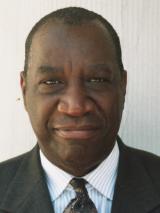Volume No. 2 Issue No. 14 - Monday September 24, 2007
The Haitian migration to Dominica – A successful experience
 By Jean Charles By Jean Charles


Jean Charles of AIDNOH
|
I travel to Dominica two to three times a year, religiously around the 1st of November to attend the Creole festival cum Independence Day. The trip from Melville Hall (the airport) to Roseau, the capital is an experience that warrants an additional fee for the excursion. Indeed for almost an hour, you go through a majestic rain forest that leaves the native unconcerned but keeps the travel connoisseur in awe to admire the splendor of the biodiversity of the island.
Dominica has been able to conserve its trees and its forest in a manner that piqued the curiosity of Christopher Columbus when he saw the island from afar. It is said, for a long time the Caribs did not hesitate to eat any foreigner who dared to set foot on firm land; but this is a material for another essay.
It is refreshing to report that the Haitian migration to Dominica is a happy and humbling experience. It started with the smugglers using Dominica as a way station to bring in Haitian women to Martinique and Guadeloupe as maids or service workers. From the Dominican Republic there was no visa requirement to enter Dominica; by posting a bond of $400 the smugglers used Dominica to ferry at night young Haitian women from Portsmouth (Dominica's second town) to Martinique.
In one of my trips, I busted into a holding house where dozens of young Haitian women were cased in like sardines as if they were in the old slave boat waiting to be sold by their masters. I was flagabersted to see that the operation could be run in the open with the master smuggler conducting her business with impunity with the tacit knowledge of the public.
Some two international incidents later, the Dominican government took steps to stop the human traffic and force the Haitians to make a decision. Either choose to belong to the adopted country or be deported. Since then, the Haitians have settled firmly in Dominica. The integration has been easy, Creole is spoken widely in the island, the culture is almost the same, the food staple is familiar and even the music has the same African-Brittany roots.
The President of Dominica told me that his gardener (a Haitian man) shares his discarded law books. The Mayor of Roseau has a land share arrangement with a Haitian migrant. They have brought their agricultural skills to Dominica, helping the country to improve and to build their crops. Always entrepreneurial, the Haitians have opened several business ventures such as barber shops, tailoring, restaurants and art shops. The Haitian artists contribute with their paintings the enchanting panorama that confuses art and reality.
The Dominican women have told me, they have found the Haitian men responsible, hard workers and an excellent mate. There are around 4,000 Haitian migrants in Dominica, with a population of some 80.000 natives. It is pleasant to report that the relationship between these newcomers is evolving admirably with no conflict and no hard feelings.
The Haitians have brought to Dominica the strength of the Creole culture, which is almost material for a museum, though in full display on Creole Day around the Independence fiesta season. In a sea of inhospitality where the Haitians are mistreated from the Bahamas to Jamaica, the model of Dominica is indeed a refreshing one.
It is the business of the Haitian government to render Haiti a place hospitable for its own people; in the meantime, Haitians will continue to flock to friendlier settings in search of a better life. Dominica, its people and its government should be inscribed in the Haitian National Frontispiece as a benefactor who, like Lady Liberty, took in the tired, the poor huddled masses yearning to breathe free, the refuse of the teeming shore, the homeless and the tempest. She has welcomed the Haitians with open arms until Haiti becomes a nation hospitable to its own people.
Jean H Charles, MSW, JD is Executive Director of AIDNOH Inc., a non profit public institute organization dedicated to making the Caribbean a gentler and kinder zone for all. He can be reached at [email protected]
|
|





